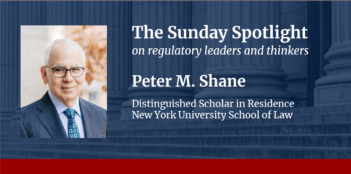
The National Labor Relations Board would benefit from the creation of a new court.
The National Labor Relations Board (NLRB) has been the subject of continuing criticism for its constant reversal of agency law with each change of administration. Indeed, Board “flip-flopping” on labor law in this country has gotten progressively worse. Labor, management, and all stakeholders affected by the National Labor Relations Act would benefit from more clarity and consistency in the interpretation and application of that statute. It is questionable, however, whether the present structure of the agency can meet these important objectives.
Furthermore, the future of the Board has been cast in doubt by President Donald J. Trump’s removal of a Democrat member of the Board, Gwynne Wilcox. Wilcox has contested her termination, and the ensuing litigation has resulted in conflicting decisions in the courts. The ultimate resolution of Wilcox’s fate and the question of whether the President has the right to remove U.S. Senate-confirmed members of multimember agencies such as the NLRB without cause will likely be decided by the U.S. Supreme Court. No matter how the Court may rule, the constitutional challenge to the Board’s structure creates an opportunity for both labor and management to consider how to refashion the Board into an exclusively adjudicatory agency likely to pass constitutional requirements and, at the same time, reduce the incidence of extreme policy oscillation that has plagued the agency for decades.
Some may welcome the potential demise of the Board. We do not. The country needs an impartial decision-making body to resolve workplace labor disputes and hold secret ballot elections to decide whether particular groups of workers wish to be represented by a labor union. The NLRB and its administrative structure, however, need a serious overhaul. We propose a solution: The U.S. Congress could create, under its authority granted by Article I of the U.S. Constitution, a new court—a labor court. Judges on the new court would serve for a six-year term and would rotate off the court every two years on a staggered basis, unless renominated by the President and reconfirmed by the Senate. The new court would consist of two independent, two Democrat, and two Republican judges, all appointed by the President, with the Senate’s advice and consent. For an individual to qualify as an independent judge, the individual could not have represented either labor or management interests and could not have participated in any court filings or as an expert witness in support of a labor or management position for the immediate six-year period prior to being nominated. The individual would also have to evidence a strong propensity for neutral and independent thinking through writings, teaching, interactions with unions and employers, and positions taken before courts and regulatory agencies, including in amicus briefs. Precedent could only be reversed by four votes of the court.
The new court would appoint administrative law judges (ALJs) to handle trials and would function as its trial division. Such appointments would require four votes from members of the court, and the appointments would be for renewable, six-year terms, subject to dismissal for cause by a vote of four members of the court.
The new court would decide appeals from ALJs and election-related appeals from regional directors of the Board. The Board’s Office of General Counsel would be statutorily separated from the court. It would be directed by a general counsel—as now, an individual appointed by the President with the Senate’s consent and removable at-will by the President. The General Counsel would have authority over the Board’s regional offices. The Board’s regional offices would continue to hold representation elections, decide election-related disputes, and investigate unfair labor practice charges. If a regional office, pursuant to the general counsel’s guidance, determined that an unfair labor practice charge had merit, it would issue a complaint, and the general counsel would prosecute the complaint before an ALJ. Any party adversely affected by an ALJ decision could appeal to the new court.
If the general counsel found, after an investigation, good cause to seek preliminary injunctive relief against an employer or union to remedy an unfair labor practice, the general counsel would present the case to an ALJ designated by the court. Only if the ALJ affirmed the general counsel’s finding after an expedited hearing would the general counsel have authority to seek such relief in a federal district court.
Any adversely affected party by a decision of the labor court would have the right to seek review in a federal court of appeals, as now. The general counsel, however, would not have standing to seek such review. Decisions of the labor court would trigger an immediate right of review by an adversely affected party without requiring, as at present, a refusal to bargain charge before review could be had. An Office of Solicitor would be created as a division of the new court. The solicitor would serve as the court’s attorney and make appropriate appearances in federal courts.
Finally, the new entity would be created through appointments by the next President after the 2028 election cycle. The new court would begin to function as soon as a quorum of four members was achieved. Such a quorum would have to include at least one independent judge. In the interim, the current Board structure would remain in place.
A labor court under Article I, as we propose it, would act only as an adjudicatory body. It would not have any authority to engage in substantive rulemaking. Furthermore, it would not have any executive authority. Our approach is consistent with the Supreme Court’s decision in Wiener v. United States, which recognized that Congress could insulate agency adjudicatory bodies from removal by the President without cause, and would likely survive any new interpretation or overruling of the 1935 decision in Humphrey’s Executor v. United States, where the Supreme Court unanimously ruled that members of multimember agencies could be protected from presidential removal without cause.
We hope our proposal will provide a basis for thoughtful debate and ultimately for a solution to the future of the National Labor Relations Board. As we stated above, this country needs an independent entity that adjudicates labor issues in the workplace on a nonpartisan and neutral basis. The “law of the jungle”—more accurately “the law in the streets”—in labor matters that existed prior to the passage of the National Labor Relations Act in 1935 is not an acceptable option.






